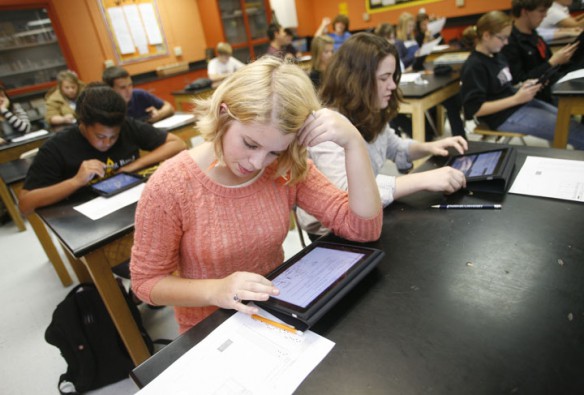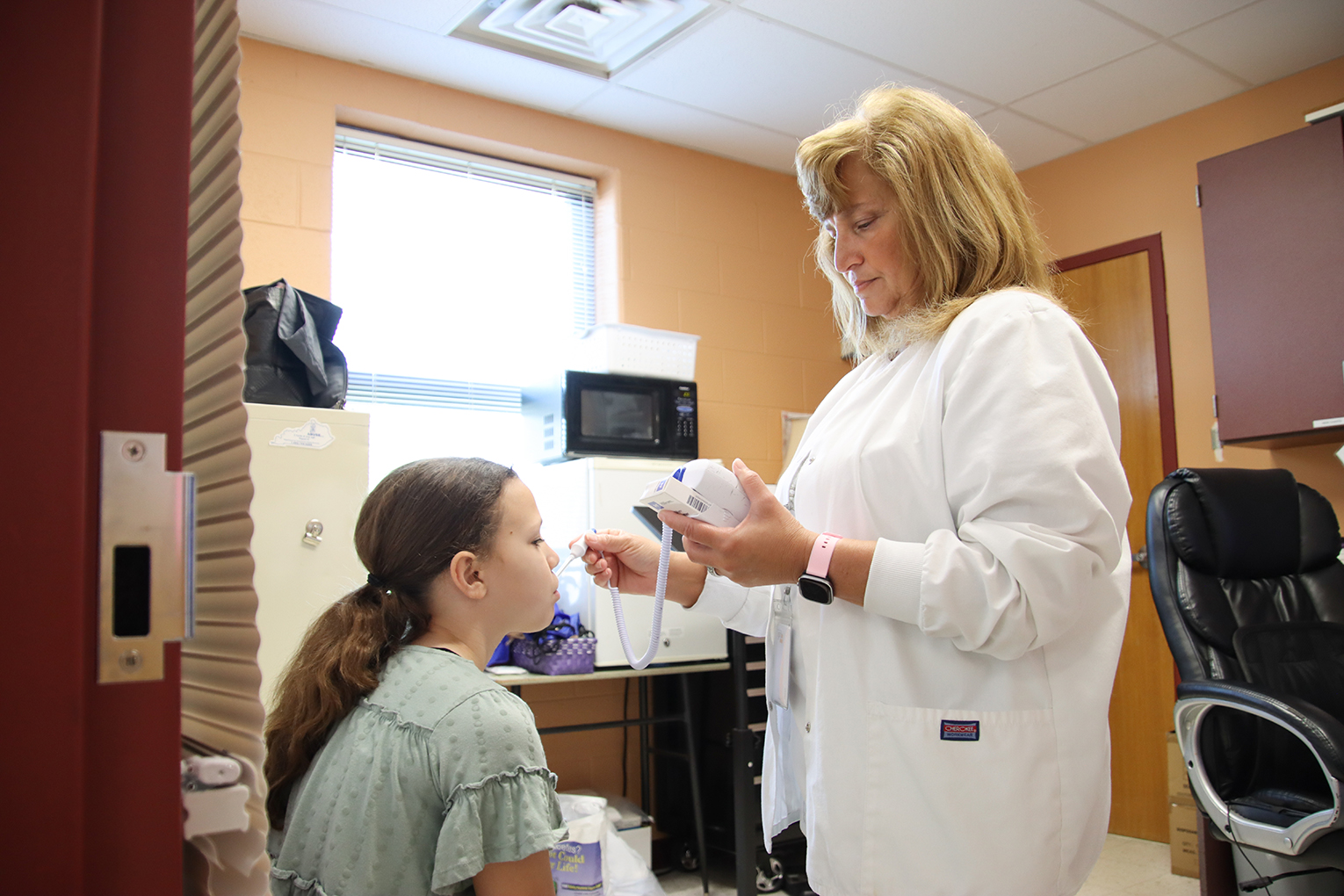
Maura Broderson compares her answers to a test she took earlier in the week using an iPad in Sandra Adams’ advanced biology class at Woodford County High School. Photo by Amy Wallot, Sept. 16, 2011
By Susan Riddell
When Woodford County High School piloted a 1:1 iPad initiative during the 2010-11 school year, science teacher Sandy Adams tried putting some questions into eClicker, an app that works like Classroom Performance Clicker Systems.
She couldn’t figure out how to make subscripts and superscripts in the app, so Ian O’Canna, one of her Chemistry AP students, figured it out for her, eventually teaching her how to do it.
“These kids tend to figure things out much quicker than I can, and they are a great resource,” Adams said of her students.
The iPads also have been great resources to the Woodford County High students.
“Students are currently using the iPads in select classrooms, and we have really seen a transformation in the classroom dynamic,” said Greg French, Woodford County school district technology director.
“Our students are digital natives,” French added. “They were born into a society that was already enriched with technological advances, so they have really embraced the opportunity to use these devices as part of their educational experience. During the pilot phase, students really drove the creative use of the devices in the classroom. They are very adept at finding ways to utilize technology in the classroom.”
District and high school staff members began talking about the iPad initiative in 2009 as part of a new focus on 21st-century digital learning.
Their goals included increasing student engagement, collaboration and access to content; creating equity in access; individualizing the learning environment; and preparing for the change from paper to digital media.
“One of the primary issues in most schools is that access to the Internet is limited by the number of available computer labs in the school,” French said. “At Woodford County High School, we have four labs, but three are used for business classes. That leaves 1,250 students and 80 teachers sharing one computer lab. Common sense math would tell you that this does not allow teachers to leverage technology instructionally, and it limits students’ access to the breadth of information available on the Web.
“We formed a Woodford NxGL (Next-Generation Learning) initiative committee and began researching 1:1 initiatives around the nation,” French added. “We visited schools around the state that already provided every student with a computing device, and we started to see the educational value in providing students with 24/7 access to school resources.”
This past school year the high school piloted iPads in six classrooms with more than 400 students. The pilot was successful and gave teachers more instructional and resource options in the classroom, French said. The Woodford County Board of Education approved the Woodford NxGL initiative this past spring, and all students at the school are scheduled to receive iPads this fall.
“This initiative was possible because our superintendent and the Woodford County Board of Education really put a premium on preparing students for their future and not our past,” French said. “Scott Hawkins, our superintendent, has championed the idea of 1:1 computing during his tenure, and it has been an incredible experience to make the vision a reality.”
Teachers are benefitting from the iPads, too.
Giving every student 24/7 access to content allows teachers to really extend the classroom and provide all of the resources in one location,” French said. “We have online classrooms that really help teachers and students communicate expectations and resources. Teachers also are able to leverage prescriptive Web-based tutorials and assignments that students can now work on at home, because all students, regardless of their background, have the technology available at home.”
Adams, like other teachers who helped pilot the program, has found the iPads helpful in many ways.
“I tend to spend less time in typical lecture format since using the iPads,” she said. “After I present the materials, students can self-pace more and use the iPads as a tool for review and practice.
“I use them for apps to allow students to play games in order to review science concepts,” Adams added. “I also use the district’s Moodle site for my iLearn classroom where I post notes, worksheets and articles, and create quizzes for students to take on their iPads as exit slips or tests. I also post videos of lessons for students to view as extra review of concepts taught in class.”
French said there are thousands of educational apps that give students opportunities to interact with information though digital game-based learning.
For example, one popular, free app allows Chemistry students to compete against one another to see who can match the most polyatomic ions.
“This is the type of software that adds value to the classroom and increases the students’ interest level,” French said.
French said the iPads create more opportunities for teachers to extend the classroom instruction into the home.
“Every teacher will have his or her own unique way of utilizing the device in the classroom. We expect teachers will be at different levels of implementation, and that is okay,” he said. “What is neat about a 1:1 initiative is that the device is actually the students’ learning tool, and creating equity of access for all students is a great investment in their future. Through one device students have access to their texts, online classrooms, the Internet, notes, atlases and graphing calculators. The possibilities are limitless.”










Leave A Comment